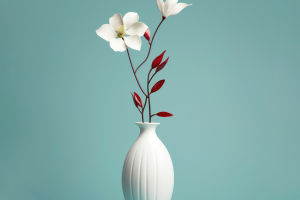Flowers have a universal language, but did you know their arrangement changes dramatically across cultures?
From the minimalist elegance of Japan's Ikebana to the more elaborate floral traditions in Europe, flower arrangement has been a cherished art form for centuries, reflecting the values and aesthetics of each culture.
Let's take a blooming journey across the world and explore the diverse ways people arrange their flowers!
Japan: Ikebana - Art in Simplicity
Ikebana, the ancient Japanese art of flower arrangement, emphasizes minimalism, balance, and the relationship between nature and space. Each stem, leaf, and petal in an Ikebana arrangement is positioned deliberately to create harmony between the elements.
Styles like Rikka (standing flowers) are used for formal occasions, while Moribana allows for more modern, creative expression. There's something deeply meditative about the practice of Ikebana, where even the empty spaces are as important as the blooms themselves.
Europe: Renaissance Elegance and Victorian Grandeur
Europe took flower arrangements to new heights during the Renaissance, where symmetry, color harmony, and lavish displays were all the rage. The Victorians took it further with their intricate and extravagant designs, often interpreting specific meanings from flowers - what we now call floriography.
The goal? To impress guests and showcase social status, of course! Whether displayed at weddings, funerals, or royal courts, floral art was not only about beauty but also an expression of wealth and taste.
EUROPEAN HAND TIED BOUQUET || Flower bouquet tutorial for beginners using a spiral technique
Video by Floral Revolution
China: Harmony Through Balance
China's floral art goes back thousands of years, emphasizing harmony, symbolism, and balance. Unlike Western styles that often focus on grandeur, Chinese flower arrangements are more modest but no less meaningful. Each flower, branch, or leaf symbolizes something specific - longevity, purity, or resilience - and these arrangements are often placed in homes or temples to bring positive energy.
India: Vibrant Garlands and Ritual Significance
In India, flowers are woven into the very fabric of daily life and spiritual practice. Traditional flower arrangements often take the form of garlands, known as malas, made from marigolds, jasmine, or roses. These garlands are offered at temples, worn during weddings, or draped on sacred statues.
Flowers in India hold deep symbolic meaning - lotus flowers, for instance, represent purity and divine beauty. It's not just about aesthetics; flower arrangements here are deeply connected to rituals and spirituality.
Middle Eastern Floral Traditions: Perfume and Color
In the Middle East, the appreciation for flowers goes hand in hand with the love of perfumes and gardens. Roses, jasmine, and orange blossoms are not only arranged for their beauty but also for their captivating scents. Traditional Persian gardens, known as paradises, are carefully planned with fragrant blooms, while bouquets for special occasions reflect the rich colors and fragrances of the region.
In modern times, floral displays at weddings and festivals still play an essential role, bringing both beauty and fragrance to the air.
While the techniques and styles may differ from culture to culture, one thing remains the same - flowers are universal symbols of beauty and emotion. Why not give it a try? You might just discover your inner florist!


